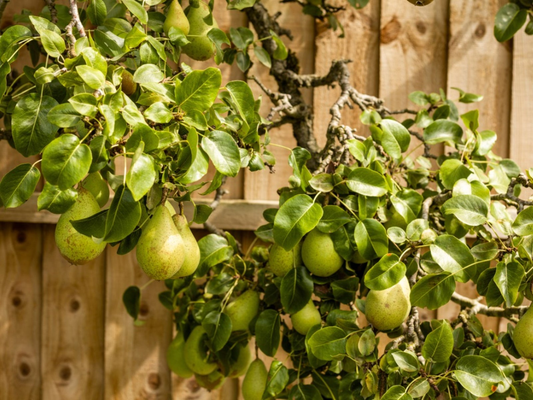Growing Fruit Trees in the USA: A Guide to Adding Freshness and Flavor to Your Garden
Share
There’s something incredibly satisfying about harvesting fruit from your own backyard. Fruit trees not only provide delicious and nutritious produce, but they also add beauty and value to your landscape. Whether you’re a seasoned gardener or just starting out, planting fruit trees in the USA is a rewarding venture. In this guide, we’ll explore some of the best fruit trees you can grow, how to care for them, and tips for ensuring a bountiful harvest.

- Apples (Malus domestica)
Apple trees are a staple in many American gardens. With countless varieties to choose from, you can find one that suits your climate and taste preferences. Popular varieties include Honeycrisp, Granny Smith, and Red Delicious.
- Climate: Apple trees thrive in USDA Zones 4-8.
- Planting Tips: Choose a sunny spot with well-draining soil. Plant in the fall or early spring for the best results.
- Care: Regular pruning and thinning of the fruit help improve the quality of your apples. Watch out for pests like apple maggots and codling moths.

- Pears (Pyrus communis)
Pears are another excellent choice for home gardeners. They are relatively low-maintenance and offer a sweet, juicy reward.
- Climate: Suitable for USDA Zones 4-9.
- Planting Tips: Plant pear trees in full sun with well-drained soil. Most varieties require cross-pollination, so plant at least two different varieties.
- Care: Pruning is essential to maintain the tree’s shape and encourage fruit production. Protect your trees from fire blight by choosing resistant varieties.

- Peaches (Prunus persica)
Few things compare to the taste of a ripe, juicy peach plucked straight from the tree. Peaches are a popular choice in warmer climates.
- Climate: Ideal for USDA Zones 5-9.
- Planting Tips: Peaches need full sun and well-drained, sandy soil. Plant in early spring for the best results.
- Care: Peaches are susceptible to pests like peach tree borers and diseases like peach leaf curl. Regular spraying and good orchard hygiene are crucial.

- Cherries (Prunus avium and Prunus cerasus)
Cherries, whether sweet or tart, are a delightful addition to any garden. They’re great for fresh eating, baking, and preserving.
- Climate: Sweet cherries thrive in USDA Zones 5-7, while tart cherries are more cold-hardy, suitable for Zones 4-8.
- Planting Tips: Cherry trees need full sun and well-drained soil. Sweet cherries require cross-pollination, so plant at least two varieties.
- Care: Prune cherry trees in late winter to early spring to maintain shape. Birds love cherries, so consider using netting to protect your crop.

- Citrus Trees (Citrus spp.)
If you live in a warmer region, citrus trees like oranges, lemons, and limes can thrive in your garden. These trees are not only productive but also evergreen, adding year-round interest to your yard.
- Climate: Best suited for USDA Zones 8-11.
- Planting Tips: Citrus trees need full sun and well-drained soil. They can be planted directly in the ground or grown in containers in cooler regions.
- Care: Regular watering, fertilization, and protection from frost are key. Citrus trees are prone to pests like aphids and spider mites, so monitor them closely.

- Figs (Ficus carica)
Figs are a versatile fruit that can be enjoyed fresh, dried, or in recipes. These trees are relatively easy to grow and can thrive in both pots and the ground.
- Climate: Suitable for USDA Zones 7-11, though some cold-hardy varieties can survive in Zone 6.
- Planting Tips: Figs prefer full sun and well-drained soil. In cooler climates, plant them against a south-facing wall for extra warmth.
- Care: Prune fig trees in late winter to early spring to maintain size and shape. Mulch around the base to retain moisture and protect roots from cold.

- Plums (Prunus domestica and Prunus salicina)
Plum trees are a great option for home gardeners, offering a variety of sweet and tart fruits. They can also serve as pollinators for other stone fruits.
- Climate: European plums are best suited for USDA Zones 4-9, while Japanese plums prefer Zones 5-9.
- Planting Tips: Plums need full sun and well-drained soil. Plant more than one variety to ensure good pollination.
- Care: Prune regularly to maintain tree health and shape. Protect your plums from pests like plum curculio and diseases like brown rot.

Conclusion
Growing fruit trees in your backyard is a rewarding experience that offers fresh, delicious produce and enhances your garden's beauty. Whether you live in the cold North or the sunny South, there’s a fruit tree that can thrive in your region. With the right care and attention, you can enjoy a bountiful harvest year after year. So why not start planting today and bring the taste of homegrown fruit to your table?
Are you ready to add some fruit trees to your garden? Explore our selection of high-quality trees and start growing your own fresh, delicious fruit today! Visit our website for more gardening tips and advice.




